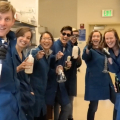Bioluminescence has evolved over 40 times independently in marine systems. We use the diverse, bioluminescent mating and defense displays of Carribean ostracods to understand the molecular basis of bioluminescence and how bioluminescence contributes to speciation.






